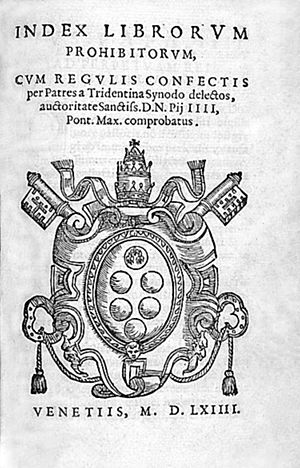Index Librorum Prohibitorum facts for kids
The Index Librorum Prohibitorum (which means "List of Prohibited Books" in Latin) was a special list of books. The Catholic Church created this list. They banned books if they thought the books contained ideas that went against Church teachings. These ideas were called heretical. They also banned books that were "anti-clerical," meaning they were against the Church's leaders or rules. This was a form of censorship used by the Catholic Church.
Contents
What Was the Index?
The Index was a way for the Church to control what people read. It was like a "forbidden list" for books. The main goal was to protect the beliefs and good behavior of people who followed the Catholic faith. They did this by stopping them from reading books that had ideas the Church thought were wrong or harmful.
Early Versions of the List
The idea of banning books wasn't new. Early versions of this list appeared in different places. For example, one was published in the Catholic Netherlands in 1529. Others came out in Venice in 1543 and Paris in 1551. By the middle of the 1500s, there were many religious wars in places like France and Germany. Leaders thought that controlling what was printed could stop "heresy" (ideas against Church teachings) from spreading. They believed a list of forbidden books, supported by both Church and government leaders, could help.
The Official Roman Index
The first official version of the Index published in Rome was in 1559. It was issued by Pope Paul IV. From 1571 until 1917, a special group called the Sacred Congregation of the Index was in charge. Their job was to keep the list updated. The very last version of the Index was published in 1948. The Index was officially stopped on June 14, 1966, by Pope Paul VI.
Why Were Books Banned?
Books were banned if they were thought to contain errors against faith or morals. This included works by famous thinkers and scientists.
Banned Thinkers and Scientists
For example, books by astronomers were sometimes on the list. Johannes Kepler's book, Epitome astronomiae Copernicanae, was on the Index from 1621 to 1835. This book discussed the idea that the Earth moves around the Sun. Philosophers also had books banned. Immanuel Kant's famous book, Critique of Pure Reason, was on the list too.
Banned Bibles
Even different editions and translations of the Bible could be banned. If the Church had not approved a specific version, it could be added to the Index.
Rules for Reading Books
The different versions of the Index also included rules. These rules explained how the Church wanted people to read, sell, and control books.
Enforcing the Index
The Inquisition was the group responsible for making sure the Index was followed. They were like a Church court.
Giordano Bruno's Case
A famous example is Giordano Bruno. He was burned at the stake on February 8, 1600. All of his writings were put on the Index that day. On the surface, he was punished for "heresy." This was not directly for his scientific ideas like heliocentrism (the idea that the Earth goes around the Sun). However, his other views, like believing in "other worlds," were also considered heresy by the Church.
Changes Over Time
It wasn't until 1822 that the Church allowed books to be printed that accepted the idea of the Earth moving. This shows how much the Church's views on science changed over centuries.
Images for kids
-
Printing press from 1811, Munich, Germany
-
Galileo being condemned in 1633.
-
René Descartes went on the Index in 1663.
See also
 In Spanish: Index librorum prohibitorum para niños
In Spanish: Index librorum prohibitorum para niños









